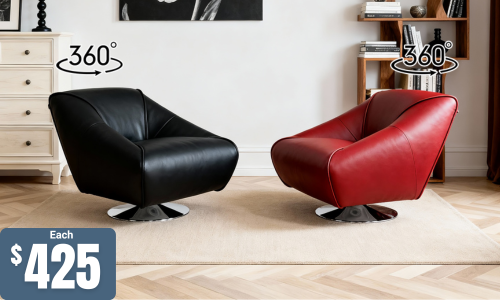Posts tagged with 'statement pieces'

Design trends may come and go, but a timeless living room remains effortlessly stylish throughout the years. By combining thoughtful elements and classic design principles, you can create a space that stands the test of time. Here's a guide to help you curate a living room that never goes out of style.
Invest in Quality Furniture
Quality over quantity is a key principle for timeless design. Opt for well-crafted pieces made from enduring materials like solid wood, leather, or high-performance fabrics. These items not only last longer but develop unique character as they age, making them even more beautiful over time. Choosing well-made furniture also reduces the need for frequent replacements, making it both an aesthetic and practical investment.
By creating a solid foundation with classic, durable furniture, your living space gains an effortlessly elegant and lasting appeal.
Pro Tip: Choose neutral tones for your larger furniture items to maintain flexibility when updating decor.
Stick to a Neutral Colour Palette
Neutral shades such as white, beige, grey, and earthy tones provide a versatile backdrop for your living room. They create a calm and balanced atmosphere while effortlessly complementing various design elements.
What makes this approach effective is the ability of neutral colours to act as timeless canvases. These shades allow you to experiment with changing trends by simply swapping accent pieces like cushions and throws, rather than redoing the entire room.
Pro Tip: Add depth to your neutral palette by layering textures, such as a woven rug, plush cushions, or linen drapes.
Incorporate Statement Pieces Thoughtfully
While keeping the core design classic, incorporating a single statement piece can elevate your living room. This could be a bold armchair, a sculptural coffee table, or an oversized piece of artwork that immediately draws the eye.
A carefully chosen statement piece injects personality into the space without overwhelming it, acting as a conversation starter and focal point.
Pro Tip: Select a statement piece that aligns with your taste and can remain a focal point for years to come.
Mix Modern and Traditional Elements
Blend old and new design elements to achieve a curated, layered look. For example, pairing a sleek sofa with a vintage rug or placing a contemporary lamp on a classic wooden side table creates an intriguing contrast. This approach works by adding depth and visual interest, preventing your living room from looking one-dimensional or monotonous. The harmony between contrasting styles brings a sophisticated edge to the overall design.
Pro Tip: Focus on balance—too much of one style can disrupt the cohesion of the room.
Prioritise Comfort
A timeless living room isn’t just about aesthetics—comfort is equally important. Plush seating, soft throws, and ergonomic furniture create an inviting environment where form meets function.
Comfort-driven designs stand the test of time because they cater to human needs, making the space enjoyable for everyday living and special gatherings alike.
Pro Tip: Opt for furniture with both form and function, such as deep-seated sofas and supportive armchairs.
Keep Clutter to a Minimum
A clean and organised space never goes out of style. Minimal clutter allows your furniture and decor choices to take centre stage and helps maintain a polished look.
The beauty of uncluttered spaces lies in their ability to feel open, airy, and serene. By reducing visual noise, you create an environment where timeless design elements can truly shine.
Pro Tip: Incorporate stylish storage solutions like built-in shelves or decorative baskets.
Creating a timeless living room is about thoughtful curation and a balance between beauty and function. By investing in quality pieces, embracing neutral palettes, and maintaining comfort, you can design a space that remains stylish year after year. Ready to transform your living room? Explore our latest collection of classic yet contemporary furniture to get started.

Transforming your living room doesn’t always require a complete overhaul. Sometimes, introducing just one powerful statement piece can redefine the atmosphere and aesthetics of your space. Whether it’s an eye-catching furniture item or a striking decor element, these impactful additions can make all the difference. Let’s explore how to use statement pieces to elevate your living room like a pro.
Choose a Hero Piece
Every great living room design has a focal point—a hero piece that immediately grabs attention and sets the stage for the rest of the decor. This could be a luxurious velvet sofa in a bold jewel tone, a sculptural coffee table with an artistic twist, or even an intricately crafted armchair.
Why it works: The hero piece becomes the anchor of your design, offering a visual resting point and defining the room’s character.
Pro Tip: When selecting your hero piece, think about functionality as well as aesthetics. A bold sofa or coffee table should not only look stunning but also fit the practical needs of your space.
Play with Colour and Texture
Vivid colours and interesting textures can turn even a simple piece of furniture into a statement item. Picture a vibrant mustard-yellow armchair set against cool grey walls or a richly textured, handwoven rug adding warmth to sleek modern flooring.
Why it works: Contrasting colours and tactile materials create visual depth, keeping the space dynamic rather than flat or monotonous.
Pro Tip: If you're hesitant to go all-in with colour, start small. Introduce accent pillows or throws in bold hues to complement your statement furniture.
Use Lighting as a Statement
Lighting isn’t just about function; it’s also a design element in its own right. Oversized pendant lights, geometric floor lamps, and chandeliers with unexpected shapes or finishes can instantly add character to your living room.
Why it works: Statement lighting pieces act as both functional tools and artistic installations, casting light while enhancing the design narrative of your space.
Pro Tip: Consider dimmable lighting options to control the room’s mood. A dramatic pendant lamp can look even more stunning with the right ambient glow.
Go Big with Art
If statement furniture isn’t your style, let oversized artwork or a carefully curated gallery wall do the talking. Abstract paintings, large photographic prints, or mixed-media art pieces can completely transform a living room.
Why it works: Artwork not only adds personality but also evokes emotion, making your living space feel complete and thoughtfully designed.
Pro Tip: When choosing wall art, focus on pieces that either complement the room's colour palette or intentionally contrast with it for added impact.
Balance is Key
While a statement piece should stand out, it shouldn’t overpower the room. Achieving balance ensures that your space remains cohesive rather than chaotic. Keep other design elements more understated to allow your hero piece to shine.
Why it works: Visual harmony prevents clutter and creates a polished, curated aesthetic where every element feels intentional.
Pro Tip: Use symmetry and repetition in small decor elements, such as matching side tables or evenly spaced plants, to frame and balance the impact of your statement item.
From daring lighting fixtures to bold furniture pieces and striking artworks, statement pieces have the power to elevate your living room without the need for a complete makeover. Start small, trust your instincts, and let your creativity guide you. Ready to find your hero piece? Explore our curated collection today for bold, beautiful furniture that speaks volumes.
.jpg) In the ever-evolving world of interior design, styles from the past often resurface, and the 60s and 70s are no exception. The swinging 60s and funky 70s were defining decades for furniture trends, characterised by bold colours, unconventional shapes, and a free-spirited approach to design. In this article, we'll embark on a nostalgic journey and explore the resurgence of 60s and 70s furniture trends, highlighting how these retro styles are experiencing a vibrant revival in contemporary British homes.
In the ever-evolving world of interior design, styles from the past often resurface, and the 60s and 70s are no exception. The swinging 60s and funky 70s were defining decades for furniture trends, characterised by bold colours, unconventional shapes, and a free-spirited approach to design. In this article, we'll embark on a nostalgic journey and explore the resurgence of 60s and 70s furniture trends, highlighting how these retro styles are experiencing a vibrant revival in contemporary British homes.
The Swinging 60s: A Burst of Colour and Innovation:
The 60s were marked by a spirit of rebellion and creativity, and this ethos was reflected in furniture design. Here are some key elements of 60s furniture trends:
- Pop Art Influence: The pop art movement had a profound impact on furniture, with its bold use of primary colours and geometric patterns. Furniture pieces often featured eye-catching, vibrant hues.
- Modular Furniture: Modular and multifunctional furniture was popular in the 60s, allowing for adaptability and a sense of individuality in home decor.
- Organic Shapes: The era embraced organic, curvilinear shapes in furniture design, from egg-shaped chairs to circular coffee tables.
- Bold Patterns: Striking patterns like florals, abstracts, and polka dots adorned upholstery, cushions, and curtains.
- Iconic Designs: The 60s introduced iconic furniture pieces, such as the Eames Lounge Chair, the Egg Chair, and the Tulip Table, which remain highly sought after today.
The Funky 70s: An Era of Groovy Style:
The 70s brought a groovy and eclectic style to furniture design. Here are some defining characteristics of 70s furniture trends:
- Earth Tones: Earthy colours like avocado green, harvest gold, and burnt orange dominated furniture and decor palettes.
- Wood and Wicker: Furniture materials such as dark wood and wicker were popular, adding warmth and texture to interiors.
- Shag Carpets: Shaggy, deep-pile carpets were a common choice, adding a tactile and retro feel to living spaces.
- Bohemian Influence: The 70s saw the rise of bohemian and hippie aesthetics, with macramé, tapestries, and low seating options becoming fashionable.
- Open Floor Plans: The 70s embraced open floor plans, and furniture designs often aimed to create versatile living spaces.
The Revival of Retro:
So, why are these retro styles making a comeback in contemporary British homes? Here are some reasons:
- Nostalgia: Many people have fond memories of the 60s and 70s, and incorporating elements of these eras into their homes evokes nostalgia and a sense of comfort.
- Timeless Appeal: The bold and unique designs of the 60s and 70s possess a timeless quality that continues to captivate homeowners and designers alike.
- Mixing Eras: Contemporary interior design often involves blending different eras and styles. Retro pieces can add character and a touch of whimsy to modern interiors.
Embracing Retro in Contemporary Decor:
To incorporate 60s and 70s furniture trends into your contemporary decor:
- Choose Statement Pieces: Select iconic retro furniture pieces like a colourful Eames chair or a funky shag rug as statement items.
- Blend with Modern: Pair retro furniture with modern elements to create a balanced and eclectic look.
- Use Retro Accessories: Incorporate retro accessories like lava lamps, vintage posters, or bold-patterned cushions to infuse a touch of nostalgia.
The resurgence of 60s and 70s furniture trends offers an exciting opportunity to embrace the past while infusing your British home with a burst of colour, creativity, and a sense of fun. Whether you opt for a single retro statement piece or go all out with a full-on throwback theme, these trends are a groovy way to add character and personality to your contemporary decor. So, let's dance to the retro revival and celebrate the enduring appeal of these iconic decades in British interior design.




.jpeg)

 (3).jpeg)
